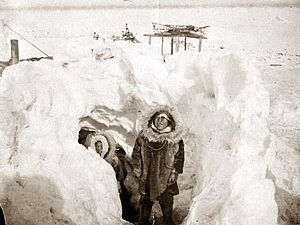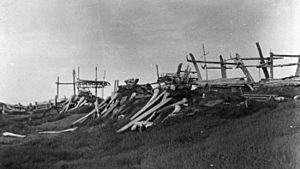Qargi facts for kids


The Qargi (pronounced "qar-ghee") was a special building used by the Yup'ik and Inuit people, and also by the Deg Xitʼan Athabaskans in Alaska. It was a large house, often built partly underground, that served many purposes. Think of it as a community center, a school, and a workshop all in one!
The Qargi was mainly a place for men. They would build and fix their boats and tools there. It was also a place for important community events like dances and ceremonies. Young boys learned about their history, songs, and how to make things from the elders. They learned survival skills and the traditions of their ancestors.
Because regular homes were not big enough, the Qargi was always a separate building. It was often two or three times larger than a typical house. It was where people gathered for storytelling, singing, dancing, and playing games. Before Christian missionaries arrived in the 1890s, most Inupiaq villages had at least one Qargi.
Different Names for the Qargi
The Qargi had different names depending on the language spoken by the people who used it. For example:
- The Central Alaskan Yupʼik people called it Qasgi or Qasgiq.
- The Cup'ik people called it Qaygiq.
- The Inupiaq people called it Qargi.
- The Inuktitut speakers in Eastern Canada called it Qaggiq.
The Qargi as a School
For a long time, the Qargi was a very important place for education. In many communities, especially for the Iñupiat people, it was the main place where young people learned. Elders taught the children about their history, their values, and important rules for living. They also taught them how to survive in their environment.
For example, in Chevak, Alaska, before the 1950s, students learned in the Qargi and in their homes. They learned everything from history to how to find food and stay safe.
Over time, as churches and modern schools became more common, the Qargi was used less for formal teaching. Today, elders often don't have the same role in teaching young Iñupiat in a formal way. However, many people believe that traditional Qargi teachings and modern schooling can work together to help young people learn.

